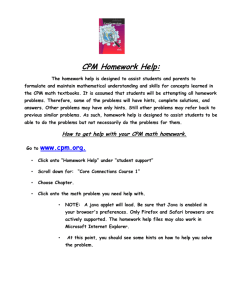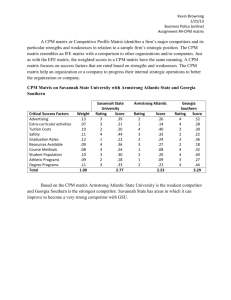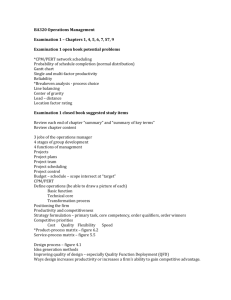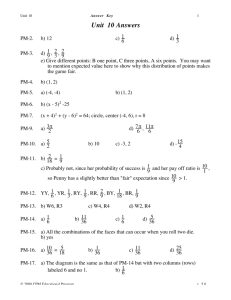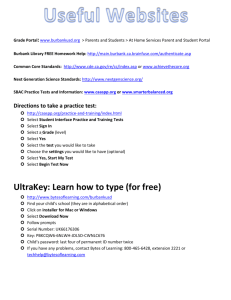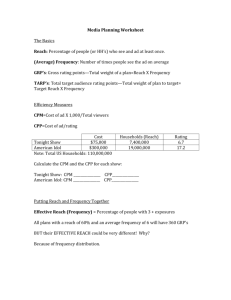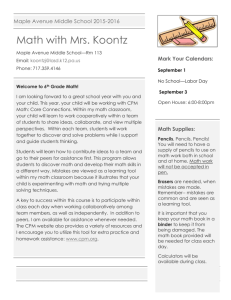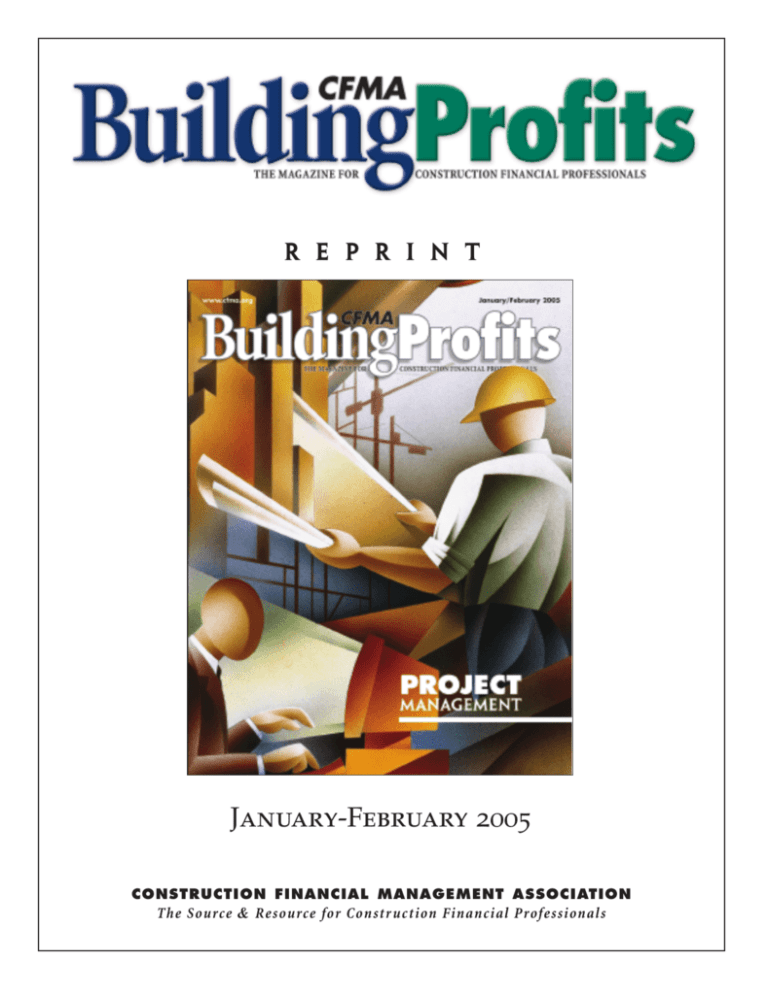
r e p r i n t
January-February 2005
CONSTRUCTION FINANCIAL MANAGEMENT ASSOCIATION
The Source & Resource for Constr uction Financial Professionals
BY MARCUS P. CONTRERAS & ANNE E. VAN DE WERKEN
USING CPM SCHEDULING to
Successfully Manage & Complete Projects
A properly developed and updated CPM
schedule creates a project road map
that can assist all stakeholders in successful planning and completion.
This article focuses primarily on the
contractor’s perspective, although CPM
scheduling also benefits owners, subs,
and sureties. For instance, the ability to
identify potential problems can give
sureties an early warning that a project
may experience profit fade. For owners,
CPM scheduling can provide a more accurate measurement of the project’s percentage-of-completion.
Every contractor who wants to complete
projects more efficiently and retain as
much profit as possible needs to understand CPM scheduling, including its origins, evolution, and advantages.
For purposes of this discussion, the
term CPM schedule means a computerized CPM schedule. This distinction is
important because, years ago, many
professionals scheduled by hand.
In our complicated industry, any advantage is
important – any edge on the competition is vital.
Critical Path Method (CPM) scheduling is a powerful
tool that helps contractors predict and mitigate problems, avoid or reduce delays, and minimize claims.
How? By identifying and focusing on critical project
activities that affect project productivity, completion,
and profitability.
CFMA BP
January-February 2005
From Manual Bar Charts to
Computerized CPM
Before the development of CPM scheduling software, professionals used manually prepared bar (Gantt) charts to
track the building of everything from the
pyramids to high-rise buildings. But, as
the industry became more complex and
competitive, contractors and owners began to understand the benefits of CPM
software.
In a seminar on “Analyzing Construction
Schedules,” Dr. William Ma, a leading
CFO’S TOOLBOX
proponent of CPM scheduling, said “The
human mind can only control 10-15 interrelated activities; a computerized CPM
schedule can control thousands of interrelated activities.”
This is one advantage of a computerized
CPM schedule. Because it tracks multiple
ongoing project activities and identifies
their impact on other project activities, the
CPM schedule provides early warnings of
unanticipated problems and gives project
participants an opportunity to resolve or
mitigate them.
The Foundation of CPM
Although an
owner may
acknowledge,
accept, or
approve
a CPM schedule,
the contractor is
ultimately
responsible
for constructing
and managing
the project.
The building blocks of a CPM schedule are
project activities, activity durations, and
activity logic. First, the scheduler composes a list of activities or tasks that are
included in the scope of work. Second, the
scheduler determines the duration or
amount of time needed to complete each activity.
Third, the scheduler must decide the sequence in which the
activities will be completed and determine how the various
activities are interrelated. This is called activity logic. Each
activity is related to another activity in one of the following
ways:
• Predecessor – An activity that must be completed before
another particular activity can start. For example, drywall
is a predecessor to painting.
• Successor – An activity that cannot start until another particular activity is complete. Painting is a successor to drywall.
• Concurrent – An activity that does not depend on the start
or finish of another activity. Installation of exterior windows is concurrent with the installation of exterior doors.
Paths & Critical Paths
A path is a group of sequentially interrelated activities that
have a predecessor or successor relationship with one
another. In the As-Planned Schedule in Exhibit 1 on the
next page, Tasks A, B, and C form Path 1, and Tasks A, D,
and E comprise Path 2.
The total duration is the sum of each activity’s duration in
a path. In the As-Planned Schedule in Exhibit 1, Path 1 has
a total duration of 40 days, and Path 2 has a total duration
of 20 days.
The path with the longest total duration is
the project’s critical path. In our example,
Path 1 is the critical path. The critical path
determines the duration of the project –
and the earliest possible completion date.
Any delay to the start or completion of Tasks
A, B, or C will cause a delay in the project’s
completion date.
The Concept of “Float”
However, not all delays cause a delay in the
project’s completion. Most activities have a
time buffer, measured in terms of calendar
days or workdays.
For example, the schedule may allow 30
days to complete electrical work, but realistically, the electrician only needs 27.
Theoretically, this activity can be delayed
three days without delaying the completion date of the project; therefore it has
three days of float.
(This is a brief and basic definition intended to introduce the
concept of float; a more comprehensive discussion of float is
beyond the scope of this article.)
The CPM Schedule
Now that we have reviewed the basic terms, let’s discuss the
CPM schedule. As previously stated, a CPM schedule is a
powerful management tool that identifies and focuses on the
critical project activities that affect project productivity, completion, and profitability. It is not a static document. As the
project develops, a CPM schedule goes through four stages:
1) Preliminary Schedule
2) As-Planned Schedule
3) Updated As-Planned Schedule
4) As-Built Schedule
The Preliminary Schedule
Many owners recognize the value of a properly developed
CPM schedule, and contract specifications that require a
computerized CPM schedule are becoming more common.
(In some cases, an independent scheduler is also required –
one who develops the CPM schedule using input from the
contractor, subcontractors, and vendors.)
Before submitting a bid or negotiating with a project owner,
the contractor should prepare a Preliminary Schedule. This
January-February 2005
CFMA BP
includes the activities to be completed and the time required
for each task. It shows how the contractor plans to build the
job.
Another advantage: It illustrates the contractor’s willingness to
manage the project using CPM.
The schedule should include equipment, labor, and other
resources the contractor plans to commit to the project,
shown on a time continuum. This is very important because,
in addition to detailing the quantity of resources needed, a
Preliminary Schedule also shows when resources are required. This allows a contractor to predict not only what
resources are needed, but also when.
Because the Preliminary Schedule does not provide sufficient detail to manage the job, the contractor must expand
upon the Preliminary Schedule after winning the contract
award. In this stage, tasks and resources are added or deleted. The expanded and refined Preliminary Schedule evolves
into the As-Planned Schedule.
The As-Planned Schedule
Subcontractors, suppliers, the contractor’s purchasing
department, and other project stakeholders should participate in scheduling the project. This will assist the contractor
Labor, company-owned equipment, purchases, and rentals
can be planned to minimize cost and maximize cash flow.
Exhibit 1: As-Planned Schedule & Updated As-Planned Schedule
Below is a sample As-Planned Schedule, the schedule created after the contract award, and the Updated As-Planned
Schedule. While these schedules do not represent actual CPM schedules – which typically track hundreds, quite often
thousands, of activities – you can see how the schedule and its critical path shift as a result of an unforeseen change.
Tasks A, B, and C are Path 1, the critical path in this schedule. Tasks A, D, and E comprise Path 2. By adding the days
required for Tasks A, B, and C, we can calculate the total duration of Path 1 as 40 days. The total duration of Path 2 is
20 days.
AS-PLANNED SCHEDULE
DURATION
START
FINISH
TASK A
10 DAYS 12/3/04 12/16/04
TASK B
10 DAYS 12/17/04 12/30/04
TASK C
20 DAYS 12/31/04 1/27/05
TASK D
5 DAYS 12/17/04 12/23/04
TASK E
5 DAYS 12/24/04 12/30/04
NOV.
11/21
11/28
DEC.
12/5
12/12
12/19 12/26
JAN.
1/2
1/9
1/16
FEB.
1/23
1/30
2/6
In the Updated As-Planned Schedule below, owner-supplied equipment for Task D arrives 25 days late. Because of the
delay, the start and finish dates for Tasks D and E shift. In addition, the critical path changes from Tasks A, B, and C
to Tasks A, D, and E.
UPDATED AS-PLANNED SCHEDULE
DURATION
START
FINISH
TASK A
10 DAYS
TASK B
10 DAYS 12/17/04 12/30/04
TASK C
20 DAYS 12/31/04
1/27/05
EQUIP. FOR TASK D
25 DAYS 12/17/04
1/20/05
12/3/04 12/16/04
TASK D
5 DAYS
1/21/05
1/27/05
TASK E
5 DAYS
1/28/05
2/3/05
CFMA BP
January-February 2005
NOV.
11/21
11/28
DEC.
12/5
12/12
12/19 12/26
JAN.
1/2
1/9
1/16
FEB.
1/23
1/30
2/6
CFO’S TOOLBOX
in establishing realistic activity durations and identifying
materials and resources (supervision, labor, equipment)
available for use on the project.
(The next page has a “CPM Schedule Preparation Checklist”
that demonstrates the comprehensive nature of a realistic
CPM schedule.)
The project manager and the project team should review the
As-Planned Schedule, asking:
• Is it comprehensive?
• Can the schedule be completed within the time
constraints?
• Are adequate resources (labor, materials, equipment,
etc.) available?
• Does the project team agree on the activity durations
and activity logic?
• Can project management use the schedule to
control the project?
A properly prepared As-Planned Schedule starts projects on
the path of success, so contractors should concentrate on
accurate schedule development. Although an owner may
acknowledge, accept, or approve a CPM schedule, the contractor is ultimately responsible for constructing and managing the project.
The Updated As-Planned Schedule
Because the As-Planned Schedule is only accurate when
every activity starts when scheduled and finishes within its
duration, frequent updates are necessary. The contractor
controls the project through schedule updates, which provide early warning signals of upcoming problems and answer
such questions as:
• Are costs within budget?
• How do changes affect the project?
• What is the total cost and impact of a change order?
• Is productivity within expectations?
• Are resources adequate to meet the contractual
completion date?
• Is the project on schedule?
• Should the project completion date be extended?
• Should the schedule be accelerated?
Updating the As-Planned Schedule also reveals changes to
critical path activities and will show if project changes have
caused a new critical path to emerge.
In the Updated As-Planned Schedule in Exhibit 1, the late
delivery of owner-supplied equipment causes the critical
path to shift from Path 1 to Path 2. Path 1, which has a time
duration of 40 days, is not affected by the equipment delay;
however, the duration of Path 2 is extended from 20 days to
45 days.
With time constraints, budget considerations, scope changes,
differing site conditions, and other major issues that affect
the project, updating the CPM schedule is vital to managing
the work.
Project changes may extend the critical path’s completion,
which always delays the job’s completion date. When this
occurs, the owner or contractor must delay completion,
extend the completion date, or accelerate the schedule.
Maintaining and controlling the schedule is the contractor’s
responsibility during the course of the project. Like any plan,
the CPM schedule must be updated with current data. The
updating process alerts contractors to potential problems
and provides management with timely information so it may
take immediate action.
The Updated As-Planned Schedule & Change Orders
The As-Planned Schedule is updated by entering the actual
start and finish dates, in addition to:
• Changes in the sequence of events (activity logic)
• Differing site conditions
• Changes to the scope of work
• Weather delays
• Holds or other owner-related delays
• Late equipment delivery
The updated schedule, and other contemporaneous documentation, provides objective data to support change order
pricing and justifies requests for extra time to complete.
Consider the equipment delay previously mentioned: If the
owner instructs the contractor to accelerate the remaining
critical path activities, a resource-loaded CPM schedule helps
the contractor price the resulting change order. (Resource
loading is the labor, equipment, and costs associated with
each scheduled activity.)
A resource-loaded schedule would show the resource costs
associated with the equipment delay. For example, did the
contractor employ a crew trained and experienced in the
installation of the owner’s equipment? Did the contractor
send other equipment and tools to the worksite for the set up
January-February 2005
CFMA BP
and installation of the owner’s equipment,
per the contract?
Also, the CPM schedule allows the contractor to simulate various acceleration scenarios to meet the owner’s desired completion
date. The resource-loaded schedule shows
the additional manpower, overtime, and
equipment needed to achieve the owner’s
objective and provides support for the pricing of the acceleration change order.
Supporting Documentation
CPM Schedule
Preparation Checklist
A comprehensive CPM schedule
is necessary to accurately
determine activity durations,
resource loads, and required
materials. Preparing a realistic
CPM schedule requires:
• A detailed scope-of-work
breakdown
• Project phases
The contractor should prepare daily field
reports to confirm and supplement the updated schedule. The daily field reports
should show, at minimum, work progress,
manpower, equipment, weather conditions,
and references to project issues.
• Major milestones
These reports are a source document for updating the CPM schedule, and will also substantiate requests for additional time and
compensation.
• Owner-furnished equip-
• Owner requirements
• Regulatory requirements
• Permit requirements
• Submittal requirements
ment and material
deliveries
• General equipment and
material deliveries
Reporting
CPM scheduling software can generate
both summarized and detailed reports and
charts for the owner, contractor, subcontractors, and other project stakeholders.
Below are some typical reports and charts:
• Planned vs. actual progress
• Planned vs. actual man-hours and
labor cost
• Planned, actual, and variances of
quantities and costs for a specific
period of time or for the project
to date
• Monthly and cumulative costs
• Cost-to-complete
• Specialized equipment
deliveries
• Project access limitations
• Labor limitations
• Work hour limitations
• Weather considerations
• Procurement schedule
• Temporary construction
• Coordination with other
contractors
• Special testing
• Special project
requirements
The As-Built Schedule
At project completion, a correct Updated As-Planned Schedule
reflects the actual activities completed, the actual durations
required to complete the activities, and the actual sequencing
of the activities completed. The final updated schedule is
called the As-Built Schedule, because it reflects how the job
was really constructed.
CFMA BP
January-February 2005
If the project was on time and under budget, the historical data is useful when planning similar jobs. The As-Built Schedule
contains valuable information regarding productivity and cost. Actual time expended,
equipment used, crew mix requirements,
and man-hours expended on specific activities will assist the contractor with future
estimates and project plans.
If the project was late and/or over budget,
the collected and recorded information may
substantiate claims for:
• Additional days and compensation
for owner delays
• Additional days and compensation
for delays caused by others
• Compensation for accelerating
project completion
• Additional impact costs
Information collected from the As-Built
Schedule, daily field reports, correspondence (including e-mails), change order
logs, request for information logs, submittal
logs, photographs, and any other contemporaneous documentation can prove damages,
support requests for additional compensation – and/or prove assertions during mediation, arbitration, or trial.
Conclusion
Because it tracks the activities that determine project completion and drive project
costs, the CPM schedule provides advance
notice of potential problems and allows
management the opportunity to avoid or
mitigate them. This is more proactive than
financial reports alone, which only notify
management of problems after the cost is
incurred or the contractor is committed to a
purchase.
Developed with forethought, updated regularly, and used to
flag problems and opportunities, a detailed CPM schedule is
a major management tool for modern contractors and other
project stakeholders. BP
CFO’S TOOLBOX
MARCUS P. CONTRERAS, CMA, CFM, is Vice President
of Finance for Engineered Construction Specialists, Inc. in
Houston. A construction management and consulting firm,
EC-Specialists (ECS) conducts forensic accounting, cost
analyses, and exhibit development.
Marc graduated magna cum laude from The University of
Houston with a BBA in Accounting. Before joining ECS, he
managed various accounting and financial departments for
energy and telecommunication companies. With ECS
since 1995, Marc has provided claims review support and
technical expertise for mediation, arbitration, and trial.
ANNE E. VAN DE WERKEN, Vice President of Project
Controls Services for Engineered Construction Specialists,
Inc. in Houston, is responsible for CPM schedule development and updates, recovery schedules, progress analysis, delay and acceleration analysis, claims, and change
orders.
Prior to working at EC-Specialists, Anne managed the
production, maintenance outages, and daily plant/turnaround scheduling for a large environmental corporation
that specialized in remediation and hazardous waste
incineration.
A longtime CFMA member, he has served on the Houston
Chapter’s Board of Directors. Nationally, Marc is Vice
Chairperson of the Education and Technology Committees, serves on the Publications Committee, and helped
develop CFMA’s Specialized Knowledge Module,
“Foundations of Construction IT.” He is also a member of
the Institute of Management Accountants (IMA).
Anne earned a BS in Chemical Engineering from Hampton University in Hampton, VA. She has presented CPM
scheduling seminars to both general contractors and subcontractors and is an active member of the ABC – having
served on its Industrial Committee and as a current member of its Commercial Committee.
Phone: 713-627-3622
E-Mail: mcontreras@ec-specialists.com
Web Site: www.ec-specialists.com
Phone: 713-627-3622
E-Mail: avandewerken@ec-specialists.com
Web Site: www.ec-specialists.com
January-February 2005
CFMA BP
Copyright © 2005 by the Construction Financial Management Association. All rights reserved. This article first appeared in CFMA Building Profits. Reprinted with permission.

